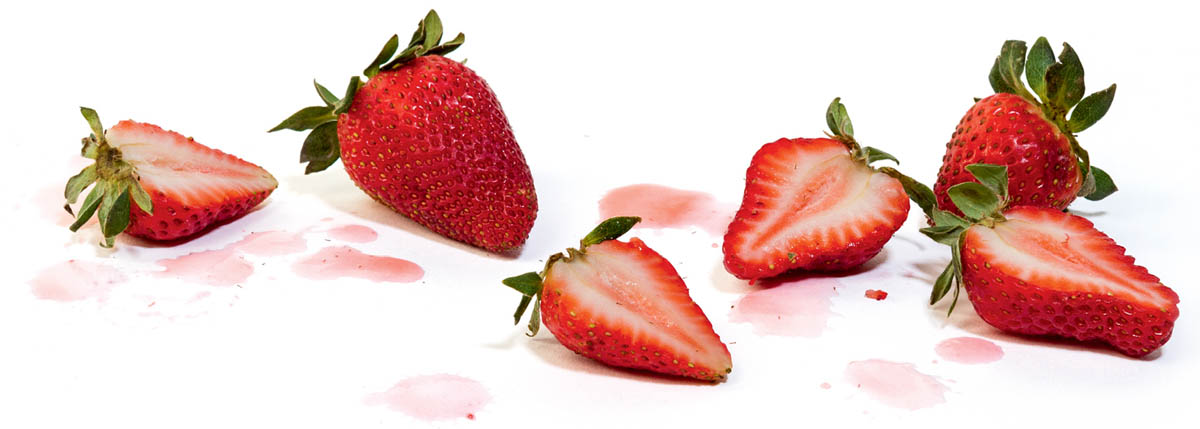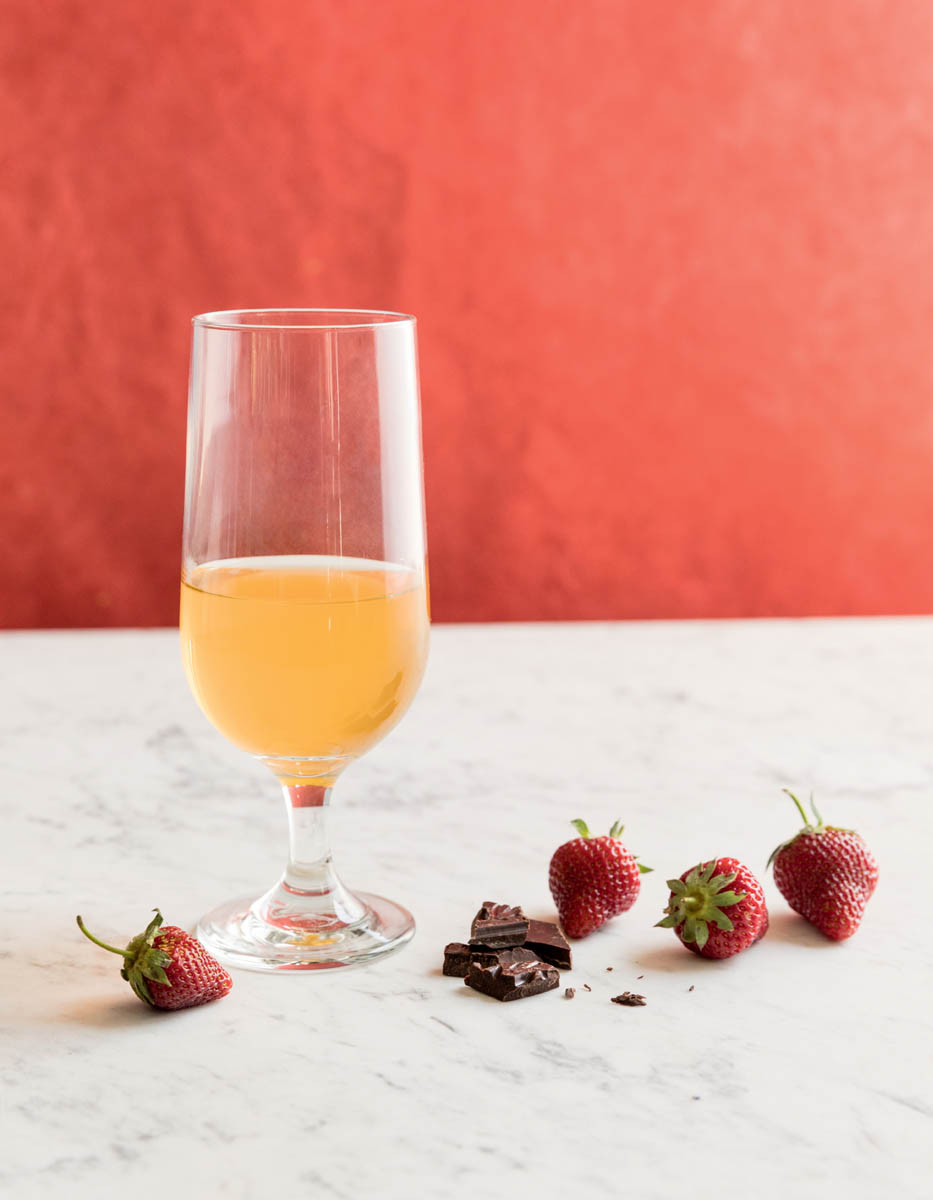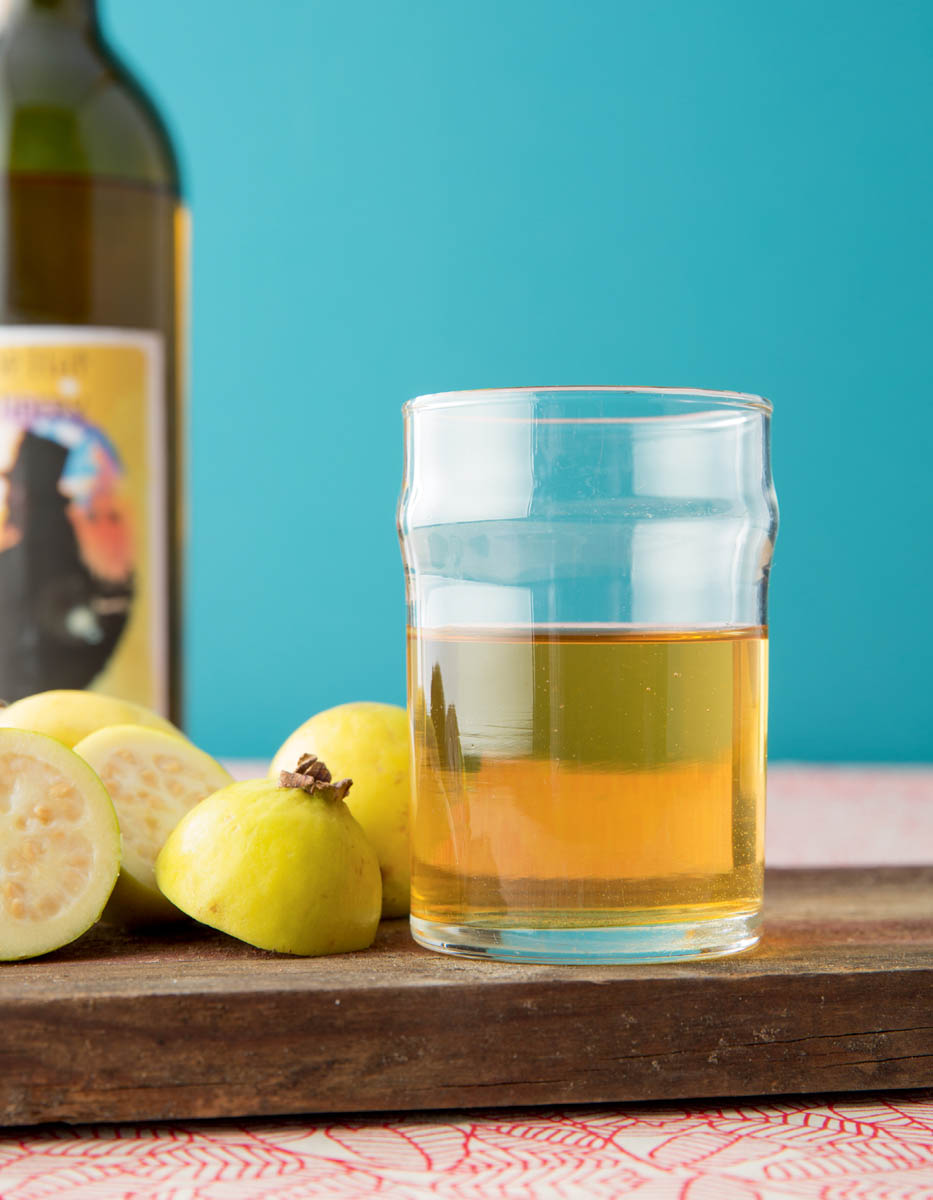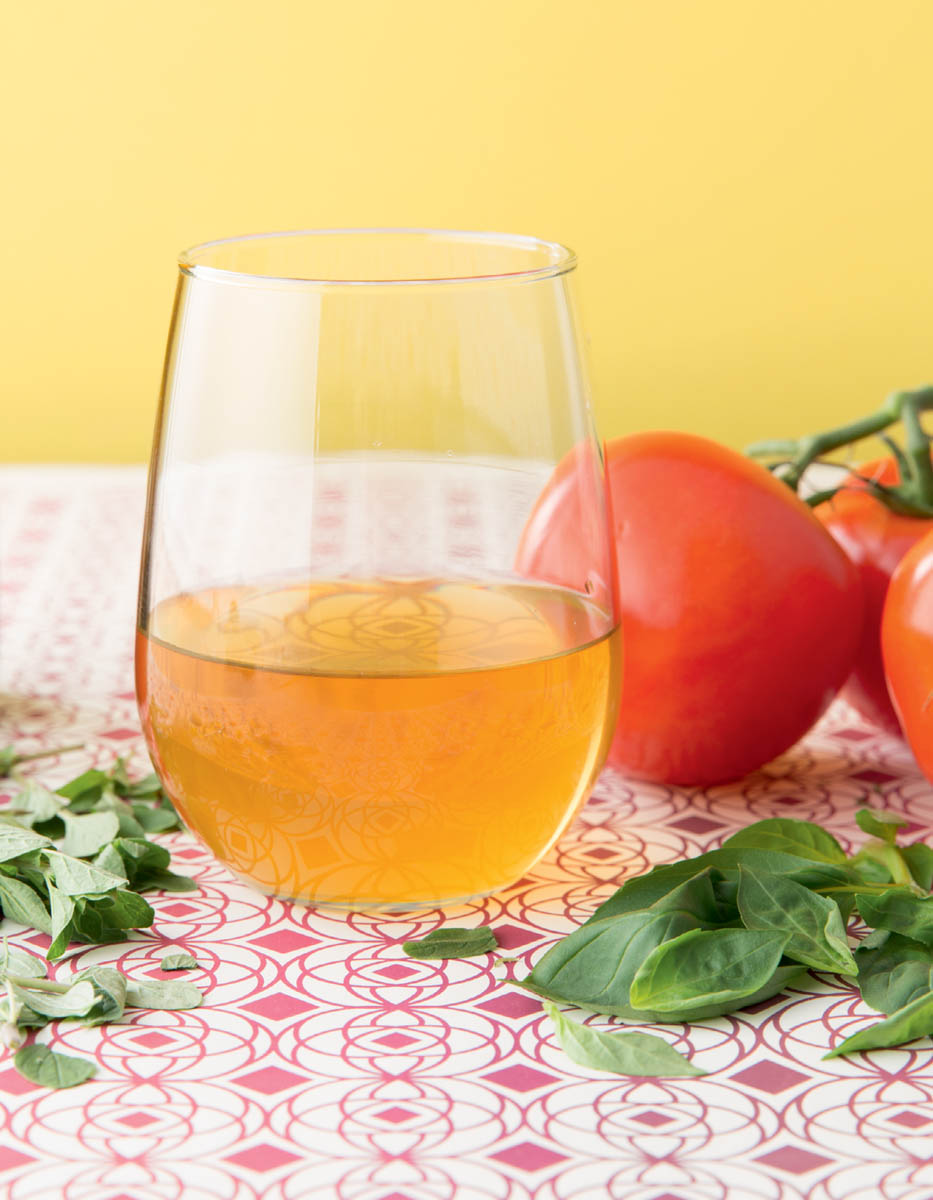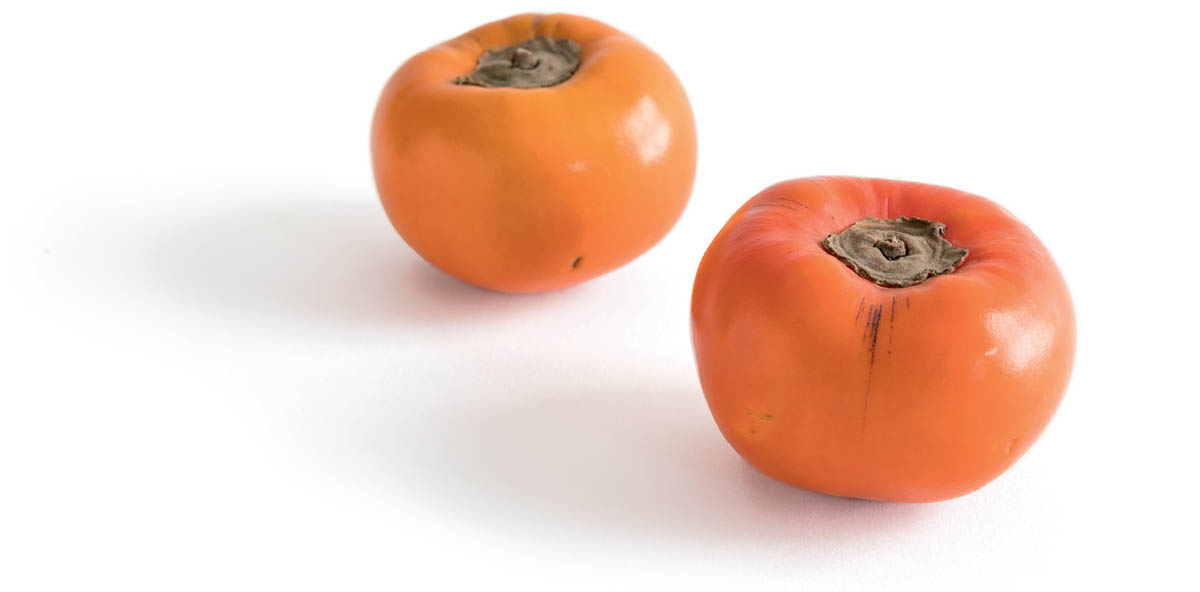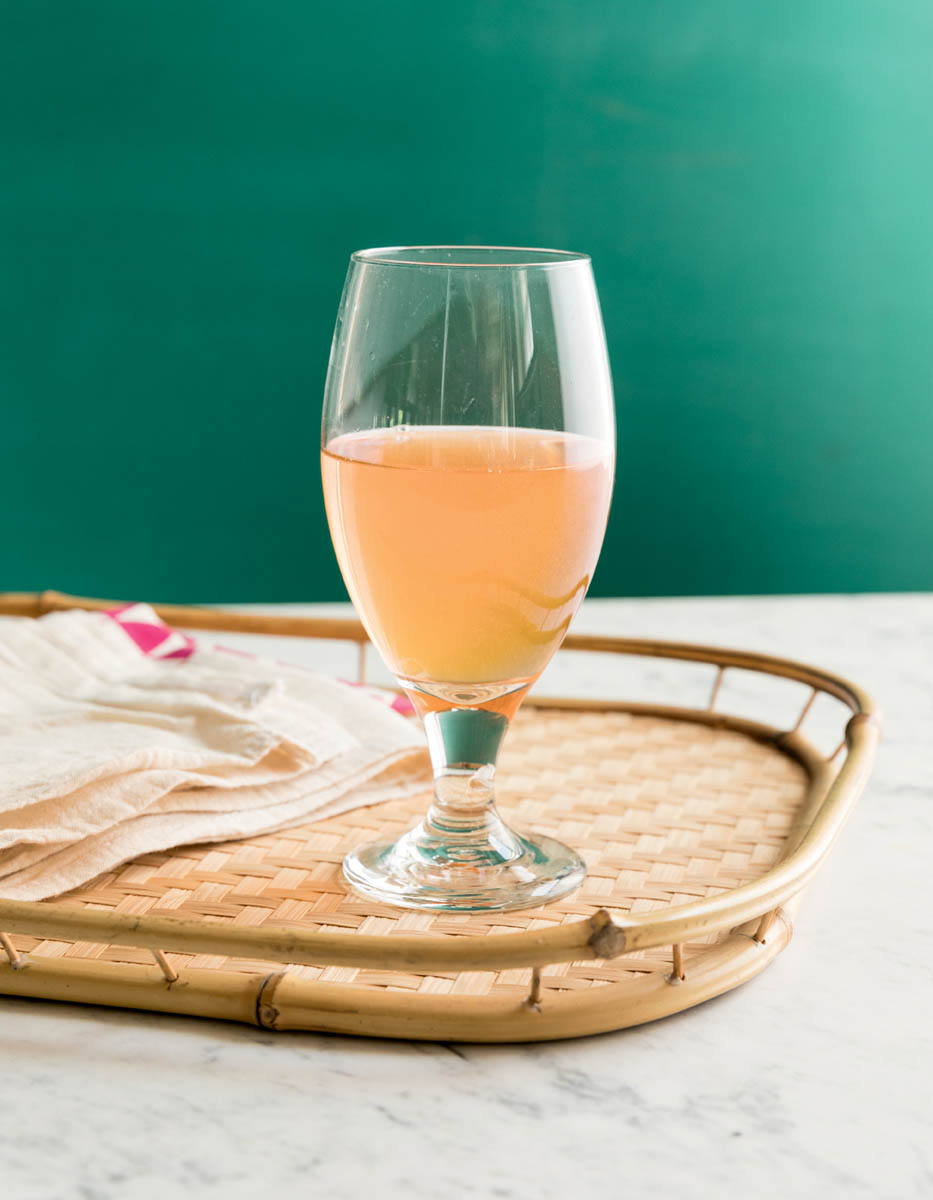Raspberry Champagne
Raspberries are one of my favorite fruits, but they can be expensive to purchase in large enough quantities to make wine (of course, if you have a large raspberry patch in your garden, all the better!). This is where raisins really come in handy to add some body and provide plenty of sugar for the yeast. This is a nice wine with beautiful color and mild raspberry flavor. More raspberries per gallon would give a more intense wine, but this recipe proves that you can still make a nice wine with a limited amount of fruit.
Ingredients
- 1 pound raisins
- 2 quarts red raspberries
- 1 gallon water
- 21⁄2 pounds sugar
- 1 packet champagne yeast
Instructions
- 1. Soak the raisins in enough water to cover overnight, then chop them, with the water, in a blender. Mash the raspberries. Combine the raisins and raspberries in the fermentation vessel.
- 2. Bring the water to a boil in a large pot. Add the sugar and bring back to a boil, stirring to dissolve the sugar. Add the boiling sugar water to the mixture in the fermentation vessel. Cover and let cool.
- 3. Stir in the yeast and cover. Stir twice a day until fermentation slows, 7 to 10 days.
- 4. Press out the pulp, pour the wine into your secondary fermentation jug, and secure the fermentation lock. Check it the next day; if there is a deep layer of lees, rack and filter the wine. Rack again every 2 to 3 months.
- 5. The wine should be ready to drink in 6 months. Let it age in the jug for as long as possible before bottling, at least 6 months to 1 year.
Red Grape
A friend gave me a case of red table grapes left over from his booth at the farmers’ market. My friend stomped them, and I added 10 pounds of sugar to make 5 gallons of wine. This will make a wine similar to many red wines sold commercially.
Ingredients
- 5 pounds red grapes
- 2 pounds sugar
- 1 gallon water
- 1 packet wine yeast
Instructions
- 1. Stomp or mash the grapes. Place them in the fermentation vessel.
- 2. Bring the water to a boil in a large pot. Add the sugar and bring back to a boil, stirring to dissolve the sugar. Add the boiling sugar water to the mixture in the fermentation vessel. Cover and let cool.
- 3. Stir in the yeast and cover. Stir twice a day until fermentation slows, 7 to 10 days.
- 4. Press out the pulp, pour the wine into your secondary fermentation jug, and secure the fermentation lock. Check it the next day; if there is a deep layer of lees, rack and filter the wine. Rack again every 2 to 3 months.
- 5. The wine should be ready to drink in 6 months. Let it age in the jug for as long as possible before bottling, at least 6 months to 1 year.
Rhubarb
Rhubarb is the most versatile ingredient I’ve used in winemaking. It combines well with any other fruit and adds an interesting complexity, but straight rhubarb wine is also very good and can have a slight rosé color if your rhubarb is red enough. There is little sugar in rhubarb, so you should use plenty of sugar and raisins.
Ingredients
- 1⁄2 pound raisins
- 2–3 quarts chopped rhubarb
- 1 gallon water
- 3 pounds sugar
- 1 packet wine yeast
Instructions
- 1. Soak the raisins in enough water to cover overnight, then chop them, with the water, in a blender. Combine the raisins and chopped rhubarb in the fermentation vessel.
- 2. Bring the water to a boil in a large pot. Add the sugar and bring back to a boil, stirring to dissolve the sugar. Add the boiling sugar water to the mixture in the fermentation vessel. Cover and let cool.
- 3. Stir in the yeast and cover. Stir twice a day until fermentation slows, 7 to 10 days.
- 4. Press out the pulp, pour the wine into your secondary fermentation jug, and secure the fermentation lock. Check it the next day; if there is a deep layer of lees, rack and filter the wine. Rack again every 2 to 3 months.
- 5. The wine should be ready to drink in 6 months. Let it age in the jug for as long as possible before bottling, at least 6 months to 1 year.
The Joys of Growing Rhubarb
I recommend that anyone serious about home winemaking should find a place in their yard to grow a couple of rhubarb plants. They are easy to grow and will produce heavily beginning just a couple of years after they’re planted. During its harvest season, collect as much rhubarb as you can, chop it, and freeze it. Later you can use it alone or combined with other fruits, herbs, or flowers to make wine.
Sake
I grew up in the Missouri Ozarks, eating all kinds of fish, bullfrogs, and crawfish, but I knew nothing of sushi until I moved to Colorado. When a close friend took me out to lunch and ordered sake to go with our sushi, explaining to me that it was rice wine, I said, “I can do that.” I knew nothing about special sake yeasts, so I just used white wine yeast and combined it with rice, raisins, and sugar. While this may not be traditional sake, it is a very nice wine that is good cold or hot. It has also aged very well in my cellar.
Ingredients
- 1⁄2–1 pound raisins
- 1 pound cooked white rice
- 1 gallon water
- 3 pounds sugar
- 1 packet wine yeast
Instructions
- 1. Soak the raisins in enough water to cover overnight, then chop them, with the water, in a blender. Combine the raisins with the rice in the fermentation vessel.
- 2. Bring the water to a boil in a large pot. Add the sugar and bring back to a boil, stirring to dissolve the sugar. Add the boiling sugar water to the mixture in the fermentation vessel. Cover and let cool.
- 3. Stir in the yeast and cover. Stir twice a day until fermentation slows, 7 to 10 days.
- 4. Press out the pulp, pour the wine into your secondary fermentation jug, and secure the fermentation lock. Check it the next day; if there is a deep layer of lees, rack and filter the wine. Rack again every 2 to 3 months.
- 5. The wine should be ready to drink in 6 months. Let it age in the jug for as long as possible before bottling, at least 6 months to 1 year.
Spiced Peach
The amount and variety of spices to use in this wine will depend on your personal taste. Good choices include cardamom, Chinese five-spice powder, cinnamon, cloves, ginger, nutmeg, pumpkin pie spice, star anise, or whichever spices you prefer. Add the spices at the beginning of the primary fermentation, then taste the must while it is fermenting to decide if you have the flavor you desire. It is better to go easy on the spices at the start, because you can always add more if the flavor is not strong enough. I consider this to be like a mulled wine that can be served warm, perhaps with a cinnamon-stick garnish.
Ingredients
- 1⁄2 pound raisins
- 3 pounds peaches
- 1⁄2 teaspoon ground nutmeg, or to taste
- 1⁄4 teaspoon ground cinnamon, or to taste
- 1⁄4 teaspoon powdered ginger, or to taste
- 1 gallon water
- 21⁄2 pounds sugar
- 1 packet wine yeast
Instructions
- 1. Soak the raisins in enough water to cover overnight, then chop them, with the water, in a blender. Pit and chop the peaches. Combine the raisins, peaches, nutmeg, cinnamon, and ginger in the fermentation vessel.
- 2. Bring the water to a boil in a large pot. Add the sugar and bring back to a boil, stirring to dissolve the sugar. Add the boiling sugar water to the mixture in the fermentation vessel. Cover and let cool.
- 3. Stir in the yeast and cover. Stir twice a day until fermentation slows, 7 to 10 days. Taste the must after a couple of days; if you would prefer a more robust spice flavor, add more of the spices.
- 4. Press out the pulp, pour the wine into your secondary fermentation jug, and secure the fermentation lock. Check it the next day; if there is a deep layer of lees, rack and filter the wine. Rack again every 2 to 3 months.
- 5. The wine should be ready to drink in 6 months. Let it age in the jug for as long as possible before bottling, at least 6 months to 1 year.
Spiced Peach-Apricot
This wine came about when I had some apricots and peaches left in the freezer and needed to make room for new crops that were getting ripe. I combined the fruits with some pumpkin pie spice and nutmeg to make a tasty spiced wine. The apricots were a nice complement to the peach flavor.
Ingredients
- 1⁄2 pound raisins
- 3 pounds mixed apricots and peaches
- 1⁄2 teaspoon ground nutmeg, or to taste
- 1⁄2 teaspoon pumpkin pie spice, or to taste
- 1 gallon water
- 21⁄2 pounds sugar
- 1 packet wine yeast
Instructions
- 1. Soak the raisins in enough water to cover overnight, then chop them, with the water, in a blender. Pit and chop the apricots and peaches. Combine the raisins, apricots, peaches, nutmeg, and pumpkin pie spice in the fermentation vessel.
- 2. Bring the water to a boil in a large pot. Add the sugar and bring back to a boil, stirring to dissolve the sugar. Add the boiling sugar water to the mixture in the fermentation vessel. Cover and let cool.
- 3. Stir in the yeast and cover. Stir twice a day until fermentation slows, 7 to 10 days. Taste the must after a couple of days; if you would prefer a more robust spice flavor, add more of the spices.
- 4. Press out the pulp, pour the wine into your secondary fermentation jug, and secure the fermentation lock. Check it the next day; if there is a deep layer of lees, rack and filter the wine. Rack again every 2 to 3 months.
- 5. The wine should be ready to drink in 6 months. Let it age in the jug for as long as possible before bottling, at least 6 months to 1 year.
Strawberry
The great flavor of strawberries translates well into wine. My only caution is that you use organic strawberries, because conventional strawberries are heavily sprayed with pesticides. Although organic strawberries cost more, the cost per bottle is still very small compared to buying commercial wines. Friends who have tasted many of my wines claim that my strawberry wine is their favorite.
Ingredients
- 1⁄2 pound raisins
- 3 pounds organic strawberries
- 1 gallon water
- 21⁄2 pounds sugar
- 1 packet wine yeast
Instructions
- 1. Soak the raisins in enough water to cover overnight, then chop them, with the water, in a blender. Cut up the strawberries. Combine the raisins and strawberries in the fermentation vessel.
- 2. Bring the water to a boil in a large pot. Add the sugar and bring back to a boil, stirring to dissolve the sugar. Add the boiling sugar water to the mixture in the fermentation vessel. Cover and let cool.
- 3. Stir in the yeast and cover. Stir twice a day until fermentation slows, 7 to 10 days.
- 4. Press out the pulp, pour the wine into your secondary fermentation jug, and secure the fermentation lock. Check it the next day; if there is a deep layer of lees, rack and filter the wine. Rack again every 2 to 3 months.
- 5. The wine should be ready to drink in 6 months. Let it age in the jug for as long as possible before bottling, at least 6 months to 1 year.
Strawberry-Chocolate
Who doesn’t like chocolate-covered strawberries? Strawberry wine is a perennial favorite, and when I discovered how well cocoa bean hulls flavor wine, I couldn’t resist making this. I got a little carried away on my first attempt and used 8 ounces of cocoa bean hulls per gallon. The chocolate flavor in that vintage was a little overpowering, so I’ve since reduced the quantity by half, but use your own judgment to suit your taste.
Ingredients
- 1⁄2 pound raisins
- 3 pounds organic strawberries
- 4 ounces cocoa bean hulls
- 1 gallon water
- 21⁄2 pounds sugar
- 1 packet wine yeast
Instructions
- 1. Soak the raisins in enough water to cover overnight, then chop them, with the water, in a blender. Cut up the strawberries. Combine the raisins, strawberries, and cocoa bean hulls in the fermentation vessel.
- 2. Bring the water to a boil in a large pot. Add the sugar and bring back to a boil, stirring to dissolve the sugar. Add the boiling sugar water to the mixture in the fermentation vessel. Cover and let cool.
- 3. Stir in the yeast and cover. Stir twice a day until fermentation slows, 7 to 10 days.
- 4. Press out the pulp, pour the wine into your secondary fermentation jug, and secure the fermentation lock. Check it the next day; if there is a deep layer of lees, rack and filter the wine. Rack again every 2 to 3 months.
- 5. The wine should be ready to drink in 6 months. Let it age in the jug for as long as possible before bottling, at least 6 months to 1 year.
Strawberry Guava
Strawberry guavas are tropical fruits about the size and shape of strawberries, with maroon skin and white flesh. They remind me a little of apples, except with softer flesh and a unique flavor. Different guavas vary in flavor, but this one can be described as pearlike with a hint of strawberry. I’ve also substituted lemon guavas for some of the strawberry guavas for a similar taste. I have never seen strawberry guavas sold commercially, but any guava you can find could be substituted in this recipe.
Ingredients
- 3 pounds strawberry or lemon guavas
- 1 gallon water
- 21⁄2 pounds sugar
- 1 packet wine yeast
Instructions
- 1. Cut up the guavas. Place them in the fermentation vessel.
- 2. Bring the water to a boil in a large pot. Add the sugar and bring back to a boil, stirring to dissolve the sugar. Add the boiling sugar water to the mixture in the fermentation vessel. Cover and let cool.
- 3. Stir in the yeast and cover. Stir twice a day until fermentation slows, 7 to 10 days.
- 4. Press out the pulp, pour the wine into your secondary fermentation jug, and secure the fermentation lock. Check it the next day; if there is a deep layer of lees, rack and filter the wine. Rack again every 2 to 3 months.
- 5. The wine should be ready to drink in 6 months. Let it age in the jug for as long as possible before bottling, at least 6 months to 1 year.
Guava Bonsai
Wild strawberry guavas in the tropics are usually heavily infested with fruit flies and other bugs, making them unsuitable for winemaking. I obtained my fruits from strawberry guava bonsai trees I was growing in my Colorado greenhouse. The trees can produce a lot of fruit, and I allowed some of them to get quite large in order to harvest enough fruit for wine. You could also use fewer guavas and add up to a pound of raisins per gallon.
Strawberry-Peach-Rhubarb
I made this wine on one of those days when I wanted to clean out my deep freezer. I didn’t have enough of any one of these ingredients to make my typical 5-gallon batch, so I combined a gallon bag of strawberries, two bags of peaches, and two bags of rhubarb. As I found, combining these fruits in the primary fermentation has a synergistic effect that can’t be matched by making these wines separately and then blending them. The flavors were quite complementary and made a very nice wine.
Ingredients
- 3–5 pounds mixed organic strawberries, peaches, and rhubarb
- 1 gallon water
- 21⁄2 pounds sugar
- 1 packet wine yeast
Instructions
- 1. Chop the strawberries and rhubarb. Pit and chop the peaches. Combine the fruits in the fermentation vessel.
- 2. Bring the water to a boil in a large pot. Add the sugar and bring back to a boil, stirring to dissolve the sugar. Add the boiling sugar water to the mixture in the fermentation vessel. Cover and let cool.
- 3. Stir in the yeast and cover. Stir twice a day until fermentation slows, 7 to 10 days.
- 4. Press out the pulp, pour the wine into your secondary fermentation jug, and secure the fermentation lock. Check it the next day; if there is a deep layer of lees, rack and filter the wine. Rack again every 2 to 3 months.
- 5. The wine should be ready to drink in 6 months. Let it age in the jug for as long as possible before bottling, at least 6 months to 1 year.
Strawberry-Rhubarb
Strawberry-rhubarb is a classic combination that works as well in wine as it does in jams and pies. You can combine the two in any ratio you desire or have available, but a 3:1 ratio is, in my opinion, a great combination. The rhubarb adds a nice tartness to the sweet strawberries, making a more complex wine than either of these alone.
Ingredients
- 3 pounds organic strawberries
- 1 pound rhubarb
- 1 gallon water
- 21⁄2 pounds sugar
- 1 packet wine yeast
Instructions
- 1. Chop the strawberries and rhubarb. Combine them in the fermentation vessel.
- 2. Bring the water to a boil in a large pot. Add the sugar and bring back to a boil, stirring to dissolve the sugar. Add the boiling sugar water to the mixture in the fermentation vessel. Cover and let cool.
- 3. Stir in the yeast and cover. Stir twice a day until fermentation slows, 7 to 10 days.
- 4. Press out the pulp, pour the wine into your secondary fermentation jug, and secure the fermentation lock. Check it the next day; if there is a deep layer of lees, rack and filter the wine. Rack again every 2 to 3 months.
- 5. The wine should be ready to drink in 6 months. Let it age in the jug for as long as possible before bottling, at least 6 months to 1 year.
Sweet Potato Sake
My mother used to give me a bushel of sweet potatoes grown by some of our farming relatives every year. Sweet potato pie is similar to pumpkin pie, so my success with pumpkin sake inspired me one year to turn that bushel of sweet potatoes into sake. I added cinnamon and nutmeg, though you could use whatever spices you prefer, for a total of 2 teaspoons per gallon. This wine is sweet with lots of spiciness. It is good cold, but heating it really brings out the flavor. It is best as a dessert wine served heated in sake cups.
Ingredients
- 1 pound raisins
- 5 pounds sweet potatoes
- 11⁄4 teaspoons ground nutmeg
- 3⁄4 teaspoon ground cinnamon
- 1 gallon water
- 21⁄2 pounds sugar
- 1 packet wine yeast
Instructions
- 1. Soak the raisins in enough water to cover overnight, then chop them, with the water, in a blender. Cut the sweet potatoes into small pieces (no need to peel). Cover them with water in a large pot, bring to a boil, and let simmer until soft, 12 to 15 minutes. Drain the potatoes and transfer them to the fermentation vessel, along with the raisins, nutmeg, and cinnamon.
- 2. Bring the water to a boil in a large pot. Add the sugar and bring back to a boil, stirring to dissolve the sugar. Add the boiling sugar water to the mixture in the fermentation vessel. Cover and let cool.
- 3. Stir in the yeast and cover. Stir twice a day until fermentation slows, 7 to 10 days.
- 4. Press out the pulp, pour the wine into your secondary fermentation jug, and secure the fermentation lock. Check it the next day; if there is a deep layer of lees, rack and filter the wine. Rack again every 2 to 3 months.
- 5. The wine should be ready to drink in 6 months. Let it age in the jug for as long as possible before bottling, at least 6 months to 1 year.
Thompson Seedless Grape
When I had the chance to pick up a bargain flat of loose Thompson grapes that had fallen off the stems, I decided to make some wine. Unfortunately, I didn’t let the grapes warm up after taking them out of the refrigerator before my friend stomped them, and she said it was not a pleasant experience (take note: don’t stomp cold fruit!). The grapes made a dry, mild wine, similar to commercial dry whites I’ve tasted.
Ingredients
- 4 pounds Thompson seedless grapes
- 1 gallon water
- 21⁄2 pounds sugar
- 1 packet wine yeast
Instructions
- 1. Mash or stomp the grapes. Place them in the fermentation vessel.
- 2. Bring the water to a boil in a large pot. Add the sugar and bring back to a boil, stirring to dissolve the sugar. Add the boiling sugar water to the mixture in the fermentation vessel. Cover and let cool.
- 3. Stir in the yeast and cover. Stir twice a day until fermentation slows, 7 to 10 days.
- 4. Press out the pulp, pour the wine into your secondary fermentation jug, and secure the fermentation lock. Check it the next day; if there is a deep layer of lees, rack and filter the wine. Rack again every 2 to 3 months.
- 5. The wine should be ready to drink in 3 to 6 months. Let it age in the jug for as long as possible before bottling, at least 6 months to 1 year.
Tomato Italiano
This wine tastes like a marinara sauce, with great flavor. I’ve used it in salad dressing in place of vinegar, adding olive oil and sea salt. It also makes a great cooking wine and marinade.
Ingredients
- 1 pound raisins
- 3 pounds tomatoes
- 1 large onion
- 3 cloves garlic
- 3 stalks celery
- 1 bell pepper
- 2 cups fresh basil
- 2 cups fresh or 1⁄4 ounce dried oregano
- 1 gallon water
- 21⁄2 pounds sugar
- 1 packet wine yeast
Instructions
- 1. Soak the raisins in enough water to cover overnight, then chop them, with the water, in a blender. Chop the tomatoes, onion, garlic, celery, and pepper, and add to the fermentation vessel, along with the raisins, basil, and oregano.
- 2. Bring the water to a boil in a large pot. Add the sugar and bring back to a boil, stirring to dissolve the sugar. Add the boiling sugar water to the mixture in the fermentation vessel. Cover and let cool.
- 3. Stir in the yeast and cover. Stir twice a day until fermentation slows, 7 to 10 days.
- 4. Press out the pulp, pour the wine into your secondary fermentation jug, and secure the fermentation lock. Check it the next day; if there is a deep layer of lees, rack and filter the wine. Rack again every 2 to 3 months.
- 5. The wine should be ready to drink in 6 months. Let it age in the jug for as long as possible before bottling, at least 6 months to 1 year.
White Mulberry
The white mulberry tree is native to China, and its leaves are the food source for silkworms. It has been widely planted as an ornamental in other parts of the world, but because birds eat the fruit and distribute the seeds on their travels, it is considered an invasive plant in parts of North America. A farmhouse I used to live in had a white mulberry tree that was loaded with fruits one year. We spread a plastic sheet under the tree and shook it, collecting two full buckets of white mulberries, which made 12 gallons of wine.
White mulberries are sweeter than red or black mulberries, but the mulberry flavor is more muted compared to the dark varieties (see Mulberry wine). This is a mild, delightful white wine with light mulberry flavor. Mulberries are a rich source of vitamins, minerals, flavonoid anthocyanins, and even resveratrol, which is usually touted as a health benefit of red wine. It is always fun to characterize your wine as health food.
Ingredients
- 3–5 pounds white mulberries
- 1 gallon water
- 21⁄2 pounds sugar
- 1 packet wine yeast
Instructions
- 1. Mash or stomp the white mulberries. Place them in the fermentation vessel.
- 2. Bring the water to a boil in a large pot. Add the sugar and bring back to a boil, stirring to dissolve the sugar. Add the boiling sugar water to the mixture in the fermentation vessel. Cover and let cool.
- 3. Stir in the yeast and cover. Stir twice a day until fermentation slows, 7 to 10 days.
- 4. Press out the pulp, pour the wine into your secondary fermentation jug, and secure the fermentation lock. Check it the next day; if there is a deep layer of lees, rack and filter the wine. Rack again every 2 to 3 months.
- 5. The wine should be ready to drink in 6 months. Let it age in the jug for as long as possible before bottling, at least 6 months to 1 year.
Wild Persimmon
A friend from my home state of Missouri knew I liked the wild persimmons that grow there, so she brought me two gallon bags of persimmon pulp as a gift on a visit. Persimmons make a very interesting wine. The fruits have a unique flavor, and wild persimmons have a stronger flavor than the large Asian persimmons that can be purchased at the grocery store. If you have never eaten a persimmon, I suggest you taste one when you have the opportunity and decide if it will make a wine that you would like. Asian persimmons would also make a good wine if you aren’t lucky enough to live where persimmons grow wild or to have such thoughtful friends.
Ingredients
- 1⁄2 pound raisins
- 2 quarts persimmons
- 1 gallon water
- 21⁄2 pounds sugar
- 1 packet wine yeast
Instructions
- 1. Soak the raisins in enough water to cover overnight, then chop them, with the water, in a blender. Cut up the persimmons. Combine the raisins and persimmons in the fermentation vessel.
- 2. Bring the water to a boil in a large pot. Add the sugar and bring back to a boil, stirring to dissolve the sugar. Add the boiling sugar water to the mixture in the fermentation vessel. Cover and let cool.
- 3. Stir in the yeast and cover. Stir twice a day until fermentation slows, 7 to 10 days.
- 4. Press out the pulp, pour the wine into your secondary fermentation jug, and secure the fermentation lock. Check it the next day; if there is a deep layer of lees, rack and filter the wine. Rack again every 2 to 3 months.
- 5. The wine should be ready to drink in 6 months. Let it age in the jug for as long as possible before bottling, at least 6 months to 1 year.
Wild Plum
Several varieties of wild plums, also called sand plums or cherry plums, grow in many regions. The plums are small (about an inch in diameter), with yellow flesh and either red or yellow skin. They have an intense flavor and can be a little tart, with less sweetness than commercial cultivated plums. You can often pick them for free along roadsides and streams, and these wild fruits make very good wine. Use at least 3 pounds of plums and 3 pounds of sugar per gallon for good flavor and fermentation.
Ingredients
- 3 pounds wild plums
- 1 gallon water
- 3 pounds sugar
- 1 packet wine yeast
Instructions
- 1. Pit and cut up the plums. Place in the fermentation vessel.
- 2. Bring the water to a boil in a large pot. Add the sugar and bring back to a boil, stirring to dissolve the sugar. Add the boiling sugar water to the mixture in the fermentation vessel. Cover and let cool.
- 3. Stir in the yeast and cover. Stir twice a day until fermentation slows, 7 to 10 days.
- 4. Press out the pulp, pour the wine into your secondary fermentation jug, and secure the fermentation lock. Check it the next day; if there is a deep layer of lees, rack and filter the wine. Rack again every 2 to 3 months.
- 5. The wine should be ready to drink in 6 months. Let it age in the jug for as long as possible before bottling, at least 6 months to 1 year.




